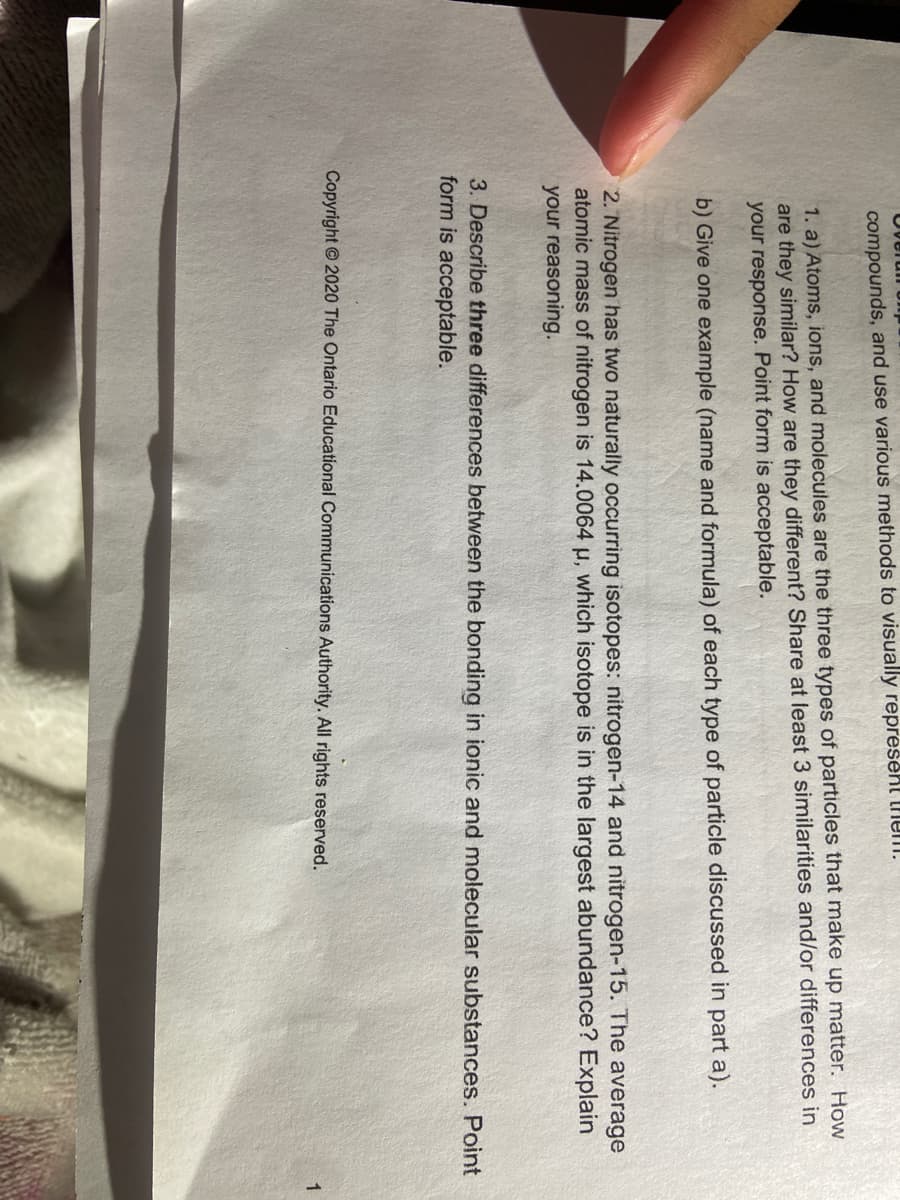2. Nitrogen has two naturally occurring isotopes: nitrogen-14 and nitrogen-15. The average atomic mass of nitrogen is 14.0064 µ, which isotope is in the largest abundance? Explain your reasoning.
2. Nitrogen has two naturally occurring isotopes: nitrogen-14 and nitrogen-15. The average atomic mass of nitrogen is 14.0064 µ, which isotope is in the largest abundance? Explain your reasoning.
Chemistry: The Molecular Science
5th Edition
ISBN:9781285199047
Author:John W. Moore, Conrad L. Stanitski
Publisher:John W. Moore, Conrad L. Stanitski
Chapter1: The Nature Of Chemistry
Section: Chapter Questions
Problem 43QRT
Related questions
Question
Number 2 please

Transcribed Image Text:Ovelun
compounds, and use various methods to visually represenl lnem.
1. a) Atoms, ions, and molecules are the three types of particles that make up matter. How
are they similar? How are they different? Share at least 3 similarities and/or differences in
your response. Point form is acceptable.
b) Give one example (name and formula) of each type of particle discussed in part a).
2. Nitrogen has two naturally occurring isotopes: nitrogen-14 and nitrogen-15. The average
atomic mass of nitrogen is 14.0064 µ, which isotope is in the largest abundance? Explain
your reasoning.
3. Describe three differences between the bonding in ionic and molecular substances. Point
form is acceptable.
Copyright © 2020 The Ontario Educational Communications Authority. All rights reserved.
1
Expert Solution
This question has been solved!
Explore an expertly crafted, step-by-step solution for a thorough understanding of key concepts.
This is a popular solution!
Trending now
This is a popular solution!
Step by step
Solved in 3 steps

Recommended textbooks for you

Chemistry: The Molecular Science
Chemistry
ISBN:
9781285199047
Author:
John W. Moore, Conrad L. Stanitski
Publisher:
Cengage Learning

Introductory Chemistry: A Foundation
Chemistry
ISBN:
9781337399425
Author:
Steven S. Zumdahl, Donald J. DeCoste
Publisher:
Cengage Learning

Principles of Modern Chemistry
Chemistry
ISBN:
9781305079113
Author:
David W. Oxtoby, H. Pat Gillis, Laurie J. Butler
Publisher:
Cengage Learning

Chemistry: The Molecular Science
Chemistry
ISBN:
9781285199047
Author:
John W. Moore, Conrad L. Stanitski
Publisher:
Cengage Learning

Introductory Chemistry: A Foundation
Chemistry
ISBN:
9781337399425
Author:
Steven S. Zumdahl, Donald J. DeCoste
Publisher:
Cengage Learning

Principles of Modern Chemistry
Chemistry
ISBN:
9781305079113
Author:
David W. Oxtoby, H. Pat Gillis, Laurie J. Butler
Publisher:
Cengage Learning

Chemistry & Chemical Reactivity
Chemistry
ISBN:
9781337399074
Author:
John C. Kotz, Paul M. Treichel, John Townsend, David Treichel
Publisher:
Cengage Learning

Chemistry & Chemical Reactivity
Chemistry
ISBN:
9781133949640
Author:
John C. Kotz, Paul M. Treichel, John Townsend, David Treichel
Publisher:
Cengage Learning

Chemistry: Principles and Reactions
Chemistry
ISBN:
9781305079373
Author:
William L. Masterton, Cecile N. Hurley
Publisher:
Cengage Learning